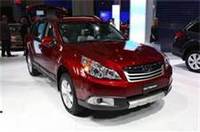Subaru Performs Strongly In Rigorous New IIHS Crash Test
 |
- All 2013 models earned the 2013 Top Safety Pick (TSP)
- In addition, the 2013 Legacy and Outback models received the all-new 2013 TSP+ award
CHERRY HILL, NJ--Dec. 20, 2012: Continuing its strong performance in crash testing, the 2013MY Subaru Forester, Subaru Impreza, Subaru XV Crosstrek, Subaru Legacy, Subaru BRZ Subaru Outback, and Subaru Tribeca vehicles have received the 2013 Insurance Institute for Highway Safety (IIHS) Top Safety Pick award (TSP).
Furthermore, the 2013 Subaru Legacy and Subaru Outback are the first Subaru vehicles to have been tested for the Institute's 2013 "TSP+" award which requires good ratings for occupant protection in at least 4 of 5 IIHS evaluations, with no less than acceptable in any test. Both vehicles are now rated as TSP+.
"The strong ratings of our products in IIHS testing supports Subaru's belief in safety," said Thomas J. Doll, executive vice president and COO, Subaru of America, Inc. "Having 100% of our models listed as IIHS Top Safety Picks and now the Legacy and Outback models tested to TSP+ status demonstrates that."
The TOP SAFETY PICK recognizes vehicles that in IIHS testing do the best job of protecting people in moderate overlap front, side, rear, and rollover crashes based on 'good' ratings in each category. The IIHS ranks in terms of Good, Acceptable, Marginal and Poor, with 'good' as the top rank possible in Institute tests. Winners also must have electronic stability control.
"For four consecutive years, Subaru is the only automotive manufacturer with the distinction of earning IIHS TOP SAFETY PICK awards for every model it builds," said Institute president Adrian Lund. "Subaru deserves praise for making safety a top priority."
About IIHS
The Institute's frontal crashworthiness evaluations are based on
results of a moderate overlap frontal and small overlap crash test. Each
vehicle's overall evaluation is based on measurements of intrusion into the
occupant compartment, injury measures recorded on a 50th percentile male
Hybrid III dummy in the driver seat, and analysis of slow-motion film to
assess how well the restraint system controlled dummy movement during the
test.
Building on its long-running vehicle ratings program for consumer information, IIHS introduced the small overlap test in 2012 to further improve occupant protection in frontal crashes. Most automakers design their vehicles for good performance in the IIHS moderate overlap frontal test and the federal government's full-width frontal test, but many haven't addressed the problem of small overlap crashes. In a 2009 IIHS study of vehicles with good ratings for frontal crash protection, small overlap crashes accounted for nearly a quarter of the frontal crashes involving serious or fatal injury to front seat occupants.
The small overlap test is a demanding crash that replicates what happens when the front corner of a car collides with another vehicle or an object like a tree or utility pole. In the test, 25 percent of a car's front end on the driver side strikes a 5-foot-tall rigid barrier at 40 mph.
Side evaluations are based on performance in a crash test in which the side of a vehicle is struck by a barrier moving at 31 mph. The barrier represents the front end of a pickup or SUV. Ratings reflect injury measures recorded on 2-instrumented SID-IIs dummies representing a small (5th percentile) woman, assessment of head protection countermeasures, and the vehicle's structural performance during the impact.
Rear crash protection is rated according to a two-step procedure. Starting points for the ratings are measurements of head restraint geometry -- the height of a restraint and its horizontal distance behind the back of the head of an average size man. Seat/head restraints with good or acceptable geometry are tested dynamically using a dummy that measures forces on the neck. This test simulates a collision in which a stationary vehicle is struck in the rear at 20 mph. Seats without good or acceptable geometry are rated poor overall because they can't be positioned to protect many people.
In the roof strength test, a metal plate is pushed against 1 side of a roof at a constant speed. To earn a good rating for rollover protection, the roof must withstand a force of 4 times the vehicle's weight before reaching 5 inches of crush. This is called a strength-to-weight ratio. For an acceptable rating, the minimum required strength-to-weight ratio is 3.25. A marginal rating value is 2.5. Anything lower than that is rated poor.


